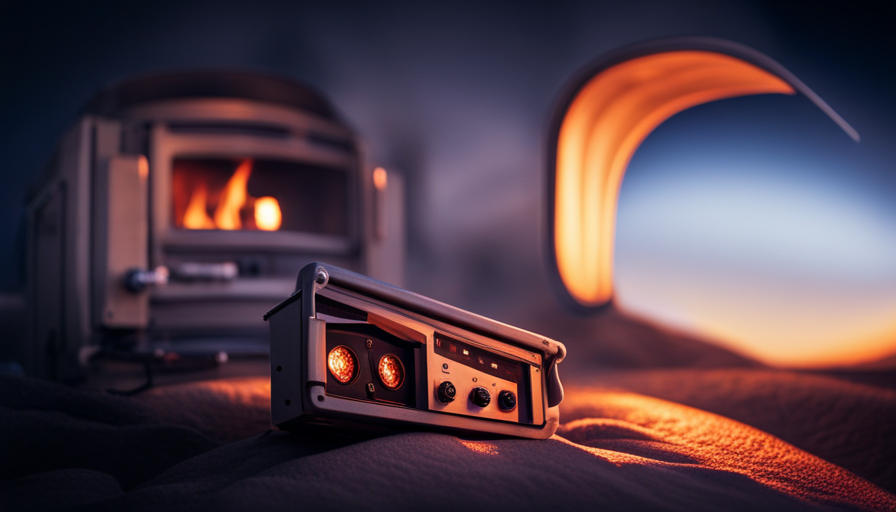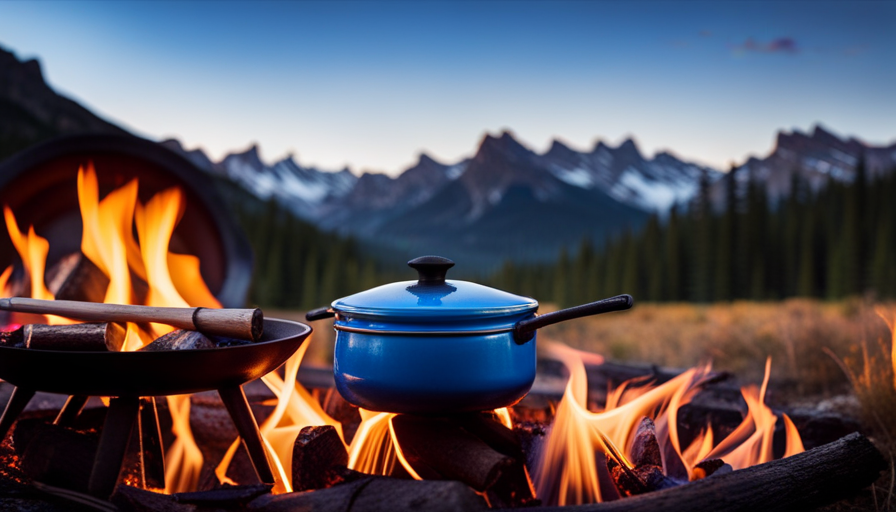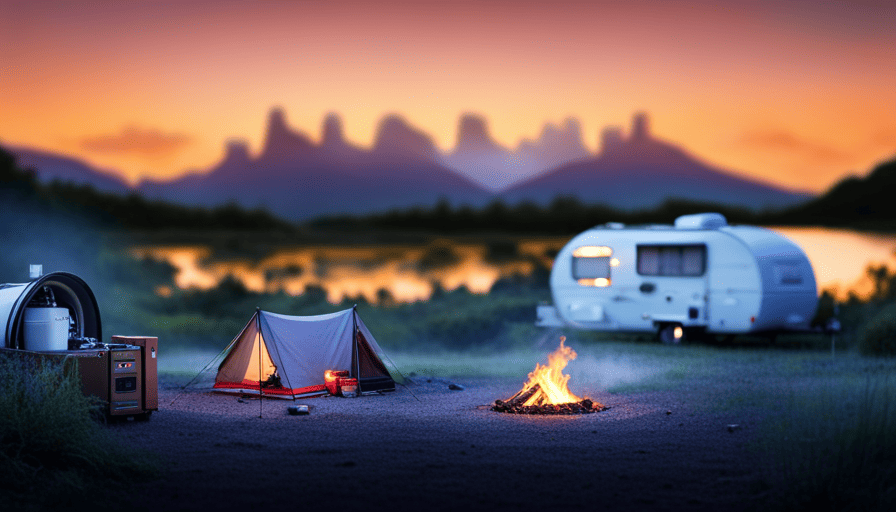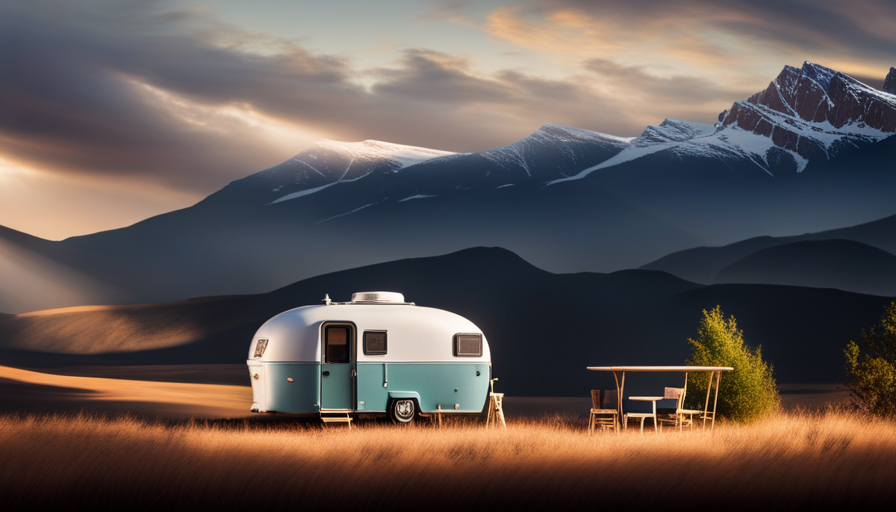Are you ready to eliminate the cold and make your camper cozy and warm? Prepare to ignite the fire of comfort and warmth as I walk you through the steps of lighting your camper’s furnace!
Picture this: as the frigid winds howl outside, you’ll be basking in the toasty embrace of your camper, thanks to a properly lit furnace. In this informative and precise article, I will guide you through the step-by-step process of lighting your camper furnace, ensuring that you’ll have a safe and cozy haven wherever your adventures take you.
From familiarizing yourself with the furnace system to testing its proper functioning, I’ll equip you with all the knowledge and tools you need to get that furnace fired up and keep it running smoothly. So, let’s dive in and discover the secrets to a warm and inviting camper experience!
Key Takeaways
- Familiarize yourself with the furnace system and common problems
- Gather the necessary tools and follow safety precautions
- Locate and clean the furnace regularly for optimal performance
- Troubleshoot and address common issues with the ignition switch and pilot light
Familiarize Yourself with the Furnace System
Familiarize yourself with the furnace system so that you’ll be able to confidently and efficiently light the camper furnace. Understanding how the furnace works and being aware of common furnace problems will help you troubleshoot any issues that may arise.
The furnace system in a camper consists of several components that work together to provide heat. The main components include the thermostat, the furnace unit itself, and the ductwork that distributes the warm air throughout the camper. It’s important to familiarize yourself with each of these components and how they function.
One common furnace problem is a malfunctioning thermostat. If the thermostat isn’t working properly, it may not send the signal to the furnace to turn on. Another common issue is a clogged or dirty furnace filter, which can restrict airflow and reduce the efficiency of the furnace.
Once you’ve familiarized yourself with the furnace system and identified any potential problems, you can move on to gathering the necessary tools and supplies for lighting the camper furnace.
Gather the Necessary Tools and Supplies
First, make sure you have all the tools and supplies needed for the task, such as a lighter or matches, a screwdriver, and a new furnace filter. Can’t imagine trying to light the furnace without these essential items? Having the necessary tools and supplies is crucial for a successful and safe operation.
To begin, let’s go over the tools and supplies needed to light the camper furnace:
-
Lighter or matches: These are used to ignite the furnace pilot light or electronic ignition system. Ensure they’re in proper working condition before starting the process.
-
Screwdriver: This tool is required to remove the access panel of the furnace. It allows you to access the internal components safely and efficiently.
-
New furnace filter: It’s essential to have a clean furnace filter to ensure proper airflow and efficient heating. Replace the old filter with a new one to maintain the furnace’s performance.
When it comes to safety precautions for lighting the furnace, always follow these guidelines:
- Ensure the camper’s properly ventilated to prevent the buildup of harmful gases.
- Turn off all electrical power sources before starting the process.
- Keep flammable materials away from the furnace area.
Now that we’ve gathered the necessary tools and supplies, let’s move on to the next step: locating the furnace and removing the access panel.
Locate the Furnace and Remove the Access Panel
To access the internal components, grab a screwdriver and remove the access panel of the furnace. Once the panel is off, you will have a clear view of the furnace’s inner workings. This is where you can troubleshoot common issues with camper furnaces and perform routine maintenance to ensure optimal performance.
One important aspect of maintaining a camper furnace is regular cleaning. Over time, dust and debris can accumulate inside the furnace, causing it to work less efficiently. To clean the furnace, refer to the manufacturer’s instructions for specific steps. Generally, you will need to remove and clean the burner assembly, inspect and clean the blower motor, and replace or clean the air filter. Regular cleaning will help prevent common issues such as reduced heating capacity or uneven heating.
To emphasize the importance of cleaning and maintenance, let’s take a look at this table:
| Issue | Cause | Solution |
|---|---|---|
| Reduced heating capacity | Dirty burner assembly | Clean or replace burner assembly |
| Uneven heating | Clogged air filter | Clean or replace air filter |
By following the recommended cleaning and maintenance procedures, you can ensure that your camper furnace operates at its best. Once you have completed these steps, it is crucial to turn off the gas supply and wait for any residual gas to disperse before proceeding to the next section.
Turn Off the Gas Supply and Wait for Any Residual Gas to Disperse
Before proceeding, make sure you turn off the gas supply and wait for any residual gas to disperse. Gas safety is of utmost importance when working with a camper furnace. By following this precaution, you reduce the risk of any potential accidents or gas leaks.
Once you’ve ensured the gas supply is turned off, it’s important to wait for a few minutes to allow any remaining gas to dissipate. This step is crucial for the safety of both yourself and the camper.
Taking the time to properly maintain your camper furnace is essential for efficient and safe operation. Regular furnace maintenance helps prevent issues and prolong the appliance’s lifespan. By turning off the gas supply and allowing any residual gas to disperse, you’re taking the necessary precautions to ensure a safe working environment.
Now that the gas supply has been turned off and any residual gas has dissipated, we can move on to the next step: locating the pilot light and ignition switch. This is an important part of the process as it allows us to proceed with lighting the camper furnace safely and effectively.
Locate the Pilot Light and Ignition Switch
Now that you’ve ensured the gas supply is turned off and any residual gas has dissipated, it’s time to locate the pilot light and ignition switch for a safe and effective lighting process.
When troubleshooting the ignition switch, it’s important to check if it’s in the correct position and functioning properly. Make sure the switch is set to the ‘off’ position before attempting to light the pilot light. If the switch appears to be faulty, consult the manufacturer’s manual or contact a professional for assistance.
Next, let’s address common pilot light problems that you may encounter. One issue you may come across is a weak or flickering pilot light. This can be caused by a dirty or clogged pilot assembly, which can be cleaned using a small wire brush or compressed air. Another common problem is a pilot light that won’t stay lit. This could be due to a faulty thermocouple, which is a safety device that detects whether the pilot light is on. If the thermocouple is malfunctioning, it may need to be replaced.
With the ignition switch troubleshooting and common pilot light problems in mind, let’s move on to the next step: lighting the pilot light using a match or ignition switch.
Light the Pilot Light Using a Match or Ignition Switch
Once you’ve located the pilot light and ignition switch, you can easily ignite it using a match or the ignition switch.
To light the pilot light using a match, first, make sure the gas supply to the furnace is turned on. Then, carefully hold a lit match near the pilot light opening while simultaneously pressing and holding down the ignition switch. This will create a spark that should ignite the gas and produce a small flame. Once the flame is lit, continue to hold down the ignition switch for a few seconds to allow the thermocouple to heat up. This will ensure that the gas valve stays open and the pilot light remains lit.
If you prefer to use the ignition switch instead of a match, simply turn the switch to the ‘pilot’ position and press and hold it down. This will activate the igniter and produce a spark, which should ignite the gas and light the pilot flame. Again, remember to hold down the ignition switch for a few seconds to allow the thermocouple to heat up and keep the flame burning.
In some cases, you might encounter issues with igniting the pilot light. Common problems include a dirty or clogged pilot orifice, a faulty ignition switch, or a malfunctioning thermocouple. If you’re experiencing difficulties, it’s important to consult the furnace’s manual or contact a professional for troubleshooting assistance.
To transition to the next section, after successfully lighting the pilot light, it’s crucial to hold down the pilot light button for a few minutes to ensure the flame stays lit.
Hold Down the Pilot Light Button for a Few Minutes to Ensure the Flame Stays Lit
To ensure the flame stays lit, you need to firmly hold down the pilot light button for a few minutes. This step is crucial in troubleshooting a camper furnace and maintaining its proper functioning.
By holding down the pilot light button, you allow the thermocouple to heat up and generate the necessary electrical current to keep the gas valve open. This ensures a continuous supply of gas to the burner, allowing the furnace to produce heat.
While holding down the pilot light button, it’s important to pay close attention to the flame. It should be a steady, blue flame with no signs of flickering or sputtering. If you notice any irregularities in the flame, it may indicate a problem with the furnace that requires further troubleshooting or maintenance.
After holding down the pilot light button for a few minutes and confirming that the flame stays lit, you can proceed to the next step of replacing the access panel and turning on the gas supply. This will complete the process of lighting the camper furnace and getting it ready for use.
Replace the Access Panel and Turn On the Gas Supply
After ensuring the flame stays lit by holding down the pilot light button, you can replace the access panel and turn on the gas supply. This step is crucial in the camper furnace troubleshooting process, as it allows the furnace to receive the necessary fuel for operation. To replace the access panel, simply align it with the designated slots and secure it in place using the provided screws. Once the panel is securely fastened, locate the gas supply valve and turn it to the "On" position. This will allow the gas to flow into the furnace, providing the necessary fuel for combustion. It is important to ensure that the gas supply is turned on properly to avoid any potential issues with the furnace’s functionality.
Now that the access panel has been replaced and the gas supply has been turned on, it is time to test the furnace to ensure proper functioning.
Test the Furnace to Ensure Proper Functioning
Now, you can make sure the furnace is operating correctly by testing it. Here are the test procedures and troubleshooting techniques you can follow:
-
Check the thermostat: Set the thermostat to the desired temperature and wait for the furnace to kick in. If it doesn’t start, ensure that the thermostat is set correctly and functioning properly. Replace the batteries if necessary.
-
Inspect the flame: Once the furnace starts, check the flame. It should be blue with a small yellow tip. If the flame is mostly yellow or flickering, it indicates an issue with the burner or gas supply. Clean the burner or contact a professional for assistance.
-
Monitor the airflow: Make sure the warm air is coming out of the vents evenly and with sufficient force. If the airflow is weak or uneven, there might be a blockage in the ductwork or a problem with the blower motor. Clean or repair as needed.
By following these test procedures and troubleshooting techniques, you can ensure that your camper furnace is functioning properly.
Now, let’s move on to the next section about safety tips for operating and maintaining your camper furnace.
Safety Tips for Operating and Maintaining Your Camper Furnace
Now that we’ve tested the furnace to ensure proper functioning, let’s talk about some important safety tips for operating and maintaining your camper furnace.
As an avid camper, I understand the importance of keeping your furnace in top shape to ensure a comfortable and safe camping experience.
First and foremost, regular maintenance is crucial for the longevity and efficiency of your furnace. Make sure to clean or replace the air filters regularly to prevent dust and debris from clogging the system. Additionally, inspect the furnace’s exhaust vent for any obstructions or blockages that could potentially lead to carbon monoxide buildup.
Troubleshooting common issues is another essential skill for any camper. If you notice that the furnace isn’t producing enough heat or is making strange noises, it might be due to a faulty ignition or a clogged burner. In such cases, it’s best to consult the manufacturer’s manual or seek professional assistance to address the problem promptly.
Remember, safety should always be the top priority when operating your camper furnace. Install a carbon monoxide detector and a smoke alarm in your camper to ensure early detection of any potential hazards. Lastly, never leave the furnace unattended or use it as a primary heat source during sleep.
By following these maintenance tips and troubleshooting common issues, you can ensure that your camper furnace operates efficiently and safely throughout your camping adventures.
Frequently Asked Questions
How often do I need to replace the access panel on my camper furnace?
The access panel on a camper furnace should be replaced as needed, depending on the condition of the panel. Regular inspection is recommended to check for any signs of wear, damage, or corrosion. If the access panel is compromised, it may lead to improper functioning of the furnace.
Additionally, troubleshooting pilot light issues should be done periodically to ensure the furnace is functioning optimally. Regular maintenance and inspection will help prevent any potential problems with the access panel and pilot light.
Can I use a lighter instead of a match to light the pilot light?
Using a lighter instead of a match to light the pilot light is possible, but it’s important to take safety precautions. Make sure to use a long-reach butane lighter to avoid burning yourself. Hold the flame near the pilot light and turn the gas knob to the pilot position.
Once the pilot light is lit, continue to hold the gas knob for about 30 seconds to allow the thermocouple to heat up. Remember to always refer to the manufacturer’s instructions for specific safety guidelines.
How long should I wait for any residual gas to disperse before attempting to light the pilot light?
I should wait for a sufficient amount of time for any residual gas to disperse before attempting to light the pilot light. This wait time is important to ensure safety and avoid any potential accidents.
It is crucial to follow the manufacturer’s instructions and guidelines for the specific furnace model, as the recommended wait time may vary.
Waiting for the residual gas to disperse will help prevent any potential ignition issues or gas leaks when lighting the pilot light.
What should I do if the pilot light does not stay lit after holding down the pilot light button for a few minutes?
What do you do if the pilot light won’t stay lit? There are a few alternative ignition methods you can try. First, make sure the gas supply is on and the thermostat is set correctly. If the pilot light still won’t stay lit, check for a dirty or clogged pilot tube, or a malfunctioning thermocouple. Troubleshooting common pilot light issues like these can help you get your camper furnace up and running again.
Are there any specific maintenance tasks I should regularly perform on my camper furnace to ensure its proper functioning?
Regular maintenance tasks are necessary to ensure the proper functioning of my camper furnace. To troubleshoot the pilot light, I should regularly clean it to remove any debris or buildup. Additionally, I should check the gas supply and ensure it’s properly connected.
Regularly inspecting the furnace for any signs of damage or wear is also important. Following these maintenance tasks will help keep my camper furnace working efficiently and prevent any issues with the pilot light.
Are these steps the same for all camper furnaces or are there different methods for different models?
When it comes to lighting a camper furnace, the steps may differ between models. It’s essential to follow the specific instructions outlined in the user manual of your particular camper furnace. The process might involve adjusting the thermostat, turning on the gas supply, and igniting the burner. It’s crucial to ensure your safety at all times while operating any camper furnace.
Conclusion
In conclusion, lighting a camper furnace is a straightforward process that requires some basic knowledge and a few simple steps. By following the outlined procedures and taking necessary safety precautions, you can ensure the proper functioning of your furnace.
Remember, safety should always be your top priority when operating and maintaining your camper furnace. So, gather your tools, locate the pilot light, and hold down the button to keep the flame alive. With these steps, you’ll be enjoying a warm and cozy camper in no time.
So, let the flame dance and the warmth embrace you on your camping adventures.










